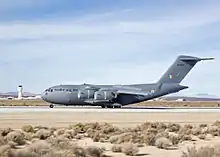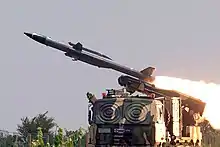Indian Air Force
The Indian Air Force (IAF) is the air arm of the Indian Armed Forces. Its complement of personnel and aircraft assets ranks fourth amongst the air forces of the world.[9] Its primary mission is to secure Indian airspace and to conduct aerial warfare during armed conflict. It was officially established on 8 October 1932 as an auxiliary air force of the British Empire which honoured India's aviation service during World War II with the prefix Royal.[10] After India gained independence from the United Kingdom in 1947, the name Royal Indian Air Force was kept and served in the name of Dominion of India. With the government's transition to a Republic in 1950, the prefix Royal was removed.
Since 1950 the IAF has been involved in four wars with neighbouring Pakistan and one with the People's Republic of China. Other major operations undertaken by the IAF include Operation Vijay, Operation Meghdoot, Operation Cactus and Operation Poomalai. The IAF's mission expands beyond engagement with hostile forces, with the IAF participating in United Nations peacekeeping missions.
The President of India holds the rank of Supreme Commander of the IAF.[11] As of 1 July 2017, 139,576 personnel are in service with the Indian Air Force.[12][13] The Chief of Air Staff, an air chief marshal, is a four-star officer and is responsible for the bulk of operational command of the Air Force. There is never more than one serving ACM at any given time in the IAF. The rank of Marshal of the Air Force has been conferred by the President of India on one occasion in history, to Arjan Singh. On 26 January 2002, Singh became the first and so far, only five-star rank officer of the IAF.[14]
Mission

- 1933–1942
- 1942–1945
- 1947–1950
- 1950 – present
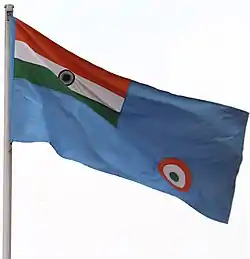
The IAF's mission is defined by the Armed Forces Act of 1947, the Constitution of India, and the Air Force Act of 1950.[16] It decrees that in the aerial battlespace:
Defence of India and every part there of including preparation for defence and all such acts as may be conducive in times of war to its prosecution and after its termination to effective demobilisation.
In practice, this is taken as a directive meaning the IAF bears the responsibility of safeguarding Indian airspace and thus furthering national interests in conjunction with the other branches of the armed forces. The IAF provides close air support to the Indian Army troops on the battlefield as well as strategic and tactical airlift capabilities. The Integrated Space Cell is operated by the Indian Armed Forces, the civilian Department of Space, and the Indian Space Research Organisation. By uniting the civilian run space exploration organisations and the military faculty under a single Integrated Space Cell the military is able to efficiently benefit from innovation in the civilian sector of space exploration, and the civilian departments benefit as well.[17][18]
The Indian Air Force, with highly trained crews, pilots, and access to modern military assets provides India with the capacity to provide rapid response evacuation, search-and-rescue (SAR) operations, and delivery of relief supplies to affected areas via cargo aircraft.[19] The IAF provided extensive assistance to relief operations during natural calamities such as the Gujarat cyclone in 1998, the tsunami in 2004, and North India floods in 2013.[19] The IAF has also undertaken relief missions such as Operation Rainbow in Sri Lanka.[19]
History
Formation and early pilots
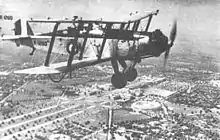
The Indian Air Force was established on 8 October 1932 in British India as an auxiliary air force[20] of the Royal Air Force. The enactment of the Indian Air Force Act 1932[21][22] stipulated out their auxiliary status and enforced the adoption of the Royal Air Force uniforms, badges, brevets and insignia.[23] On 1 April 1933, the IAF commissioned its first squadron, No.1 Squadron, with four Westland Wapiti biplanes and five Indian pilots. The Indian pilots were led by British RAF Commanding officer Flight Lieutenant (later Air Vice Marshal) Cecil Bouchier.[24]
World War II (1939–1945)
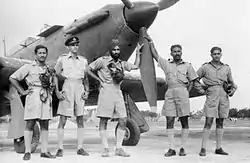
During World War II, the IAF played an instrumental role in halting the advance of the Japanese army in Burma, where the first IAF air strike was executed. The target for this first mission was the Japanese military base in Arakan, after which IAF strike missions continued against the Japanese airbases at Mae Hong Son, Chiang Mai and Chiang Rai in northern Thailand.
The IAF was mainly involved in strike, close air support, aerial reconnaissance, bomber escort and pathfinding missions for RAF and USAAF heavy bombers. RAF and IAF pilots would train by flying with their non-native air wings to gain combat experience and communication proficiency. IAF pilots participated in air operations in Europe as part of the RAF.
During the war, the IAF experienced a phase of steady expansion. New aircraft added to the fleet included the US-built Vultee Vengeance, Douglas Dakota, the British Hawker Hurricane, Supermarine Spitfire, and Westland Lysander.
In recognition of the valiant service by the IAF, King George VI conferred the prefix "Royal" in 1945. Thereafter the IAF was referred to as the Royal Indian Air Force. In 1950, when India became a republic, the prefix was dropped and it reverted to being the Indian Air Force.[25]
First years of independence (1947–1950)
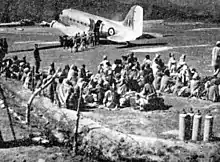
After it became independent from the British Empire in 1947, British India was partitioned into the new states of the Dominion of India and the Dominion of Pakistan. Along the lines of the geographical partition, the assets of the air force were divided between the new countries. India's air force retained the name of the Royal Indian Air Force, but three of the ten operational squadrons and facilities, located within the borders of Pakistan, were transferred to the Royal Pakistan Air Force.[26] The RIAF Roundel was changed to an interim 'Chakra' roundel derived from the Ashoka Chakra.[15]
Around the same time, conflict broke out between them over the control of the princely state of Jammu & Kashmir. With Pakistani forces moving into the state, its Maharaja decided to accede to India in order to receive military help.[27] The day after, the Instrument of Accession was signed, the RIAF was called upon to transport troops into the war zone. And this was when a good management of logistics came into help.[27] This led to the eruption of full-scale war between India and Pakistan, though there was no formal declaration of war.[28] During the war, the RIAF did not engage the Pakistan Air Force in air-to-air combat; however, it did provide effective transport and close air support to the Indian troops.[29]
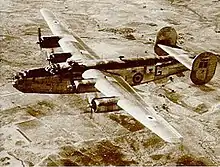
When India became a republic in 1950, the prefix 'Royal' was dropped from the Indian Air Force.[30] At the same time, the current IAF roundel was adopted.[15]
Congo crisis and Annexation of Goa (1960–1961)
The IAF saw significant conflict in 1960, when Belgium's 75-year rule over Congo ended abruptly, engulfing the nation in widespread violence and rebellion.[31] The IAF activated No. 5 Squadron, equipped with English Electric Canberra, to support the United Nations Operation in the Congo. The squadron started undertaking operational missions in November.[32] The unit remained there until 1966, when the UN mission ended.[32] Operating from Leopoldville and Kamina, the Canberras soon destroyed the rebel Air Force and provided the UN ground forces with its only long-range air support force.[33]
In late 1961, the Indian government decided to attack the Portuguese colony of Goa after years of disagreement between New Delhi and Lisbon.[34] The Indian Air Force was requested to provide support elements to the ground force in what was called Operation Vijay. Probing flights by some fighters and bombers were carried out from 8–18 December to draw out the Portuguese Air Force, but to no avail.[34] On 18 December, two waves of Canberra bombers bombed the runway of Dabolim airfield taking care not to bomb the Terminals and the ATC tower. Two Portuguese transport aircraft (a Super Constellation and a DC-6) found on the airfield were left alone so that they could be captured intact. However the Portuguese pilots managed to take off the aircraft from the still damaged airfield and made their getaway to Portugal.[34] Hunters attacked the wireless station at Bambolim. Vampires were used to provide air support to the ground forces.[34] In Daman, Mystères were used to strike Portuguese gun positions.[34] Ouragans (called Toofanis in the IAF) bombed the runways at Diu and destroyed the control tower, wireless station and the meteorological station. After the Portuguese surrendered the former colony was integrated into India.[34]
Border disputes and changes in the IAF (1962–1971)
In 1962, border disagreements between China and India escalated to a war when China mobilised its troops across the Indian border.[35] During the Sino-Indian War, India's military planners failed to deploy and effectively use the IAF against the invading Chinese forces. This resulted in India losing a significant amount of advantage to the Chinese; especially in Jammu and Kashmir.[35]
On 24 April 1965, an Indian Ouragan strayed over the Pakistani border and was forced to land by a Pakistani Lockheed F-104 Starfighter, the pilot was returned to India; however, the captured aircraft would be kept by the Pakistan Air Force and ended up being displayed at the PAF mueseum in Peshawar.[36]
Three years after the Sino-Indian conflict, in 1965, Pakistan launched Operation Gibraltar, strategy of Pakistan to infiltrate Jammu and Kashmir, and start a rebellion against Indian rule. This came to be known as the Second Kashmir War.[37] This was the first time the IAF actively engaged an enemy air force.[38] However, instead of providing close air support to the Indian Army,[39] the IAF carried out independent raids against PAF bases.[40] These bases were situated deep inside Pakistani territory, making IAF fighters vulnerable to anti-aircraft fire.[41] During the course of the conflict, the PAF enjoyed technological superiority over the IAF and had achieved substantial strategic and tactical advantage due to the suddenness of the attack and advanced state of their air force.[37] The IAF was restrained by the government from retaliating to PAF attacks in the eastern sector while a substantive part of its combat force was deployed there and could not be transferred to the western sector, against the possibility of Chinese intervention. Moreover, international (UN) stipulations and norms did not permit military force to be introduced into the Indian state of J&K beyond what was agreed during the 1949 ceasefire.[37] Despite this, the IAF was able to prevent the PAF from gaining air superiority over conflict zones.[42] The small and nimble IAF Folland Gnats proved effective against the F-86 Sabres of the PAF earning it the nickname "Sabre Slayers". By the time the conflict had ended, the IAF lost 60–70 aircraft, while the PAF lost 43 aircraft.[37] More than 60% of IAF's aircraft losses took place in Ground Attack missions to enemy ground-fire, since fighter-bomber aircraft would carry out repeated dive attacks on the same target. According to, Air Chief Marshal Arjan Singh of the Indian Air Force, despite having been qualitatively inferior, IAF achieved air superiority in three days in the 1965 War.[43]
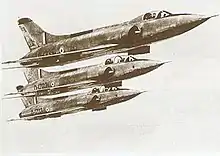
After the 1965 war, the IAF underwent a series of changes to improve its capabilities. In 1966, the Para Commandos regiment was created.[44] To increase its logistics supply and rescue operations ability, the IAF inducted 72 HS 748s which were built by Hindustan Aeronautics Limited (HAL) under licence from Avro.[45] India started to put more stress on indigenous manufacture of fighter aircraft. As a result, HAL HF-24 Marut, designed by the famed German aerospace engineer Kurt Tank,[46] were inducted into the air force. HAL also started developing an improved version of the Folland Gnat, known as HAL Ajeet.[47] At the same time, the IAF also started inducting Mach 2 capable Soviet MiG-21 and Sukhoi Su-7 fighters.[48]
Bangladesh Liberation War (1971)
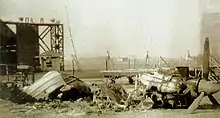
By late 1971, the intensification of the independence movement in East Pakistan lead to the Bangladesh Liberation War between India and Pakistan.[49] On 22 November 1971, 10 days before the start of a full-scale war, four PAF F-86 Sabre jets attacked Indian and Mukti Bahini positions at Garibpur, near the international border. Two of the four PAF Sabres were shot down and one damaged by the IAF's Folland Gnats.[50] On 3 December, India formally declared war against Pakistan following massive preemptive strikes by the PAF against Indian Air Force installations in Srinagar, Ambala, Sirsa, Halwara and Jodhpur. However, the IAF did not suffer significantly because the leadership had anticipated such a move and precautions were taken.[51] The Indian Air Force was quick to respond to Pakistani air strikes, following which the PAF carried out mostly defensive sorties.[52]
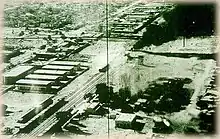

Within the first two weeks, the IAF had carried out almost 12,000 sorties over East Pakistan and also provided close air support to the advancing Indian Army.[53] IAF also assisted the Indian Navy in its operations against the Pakistani Navy and Maritime Security Agency in the Bay of Bengal and Arabian Sea. On the western front, the IAF destroyed more than 20 Pakistani tanks,[54] 4 APCs and a supply train during the Battle of Longewala.[55] The IAF undertook strategic bombing of West Pakistan by carrying out raids on oil installations in Karachi, the Mangla Dam and a gas plant in Sindh.[56] Similar strategy was also deployed in East Pakistan and as the IAF achieved complete air superiority on the eastern front, the ordnance factories, runways, and other vital areas of East Pakistan were severely damaged.[57] By the time Pakistani forces surrendered, the IAF destroyed 94 PAF Aircraft[58] The IAF was able to conduct a wide range of missions – troop support; air combat; deep penetration strikes; para-dropping behind enemy lines; feints to draw enemy fighters away from the actual target; bombing; and reconnaissance. In contrast, the Pakistan Air Force, which was solely focused on air combat, was blown out of the subcontinent's skies within the first week of the war. Those PAF aircraft that survived took refuge at Iranian air bases or in concrete bunkers, refusing to offer a fight.[59] Hostilities officially ended at 14:30 GMT on 17 December, after the fall of Dacca on 15 December. India claimed large gains of territory in West Pakistan (although pre-war boundaries were recognised after the war), and the independence of Pakistan's East wing as Bangladesh was confirmed. The IAF had flown over 16,000 sorties[53] on both East and West fronts; including sorties by transport aircraft and helicopters.[53] while the PAF flew about 30 and 2,840. More than 80 per cent of the IAF's sorties were close-support and interdiction, and according to neutral assessments about 45 IAF Aircraft were lost while, Pakistan lost 75 aircraft.[60] Not including any F-6s, Mirage IIIs, or the six Jordanian F-104s which failed to return to their donors. But the imbalance in air losses was explained by the IAF's considerably higher sortie rate, and its emphasis on ground-attack missions. On the ground Pakistan suffered most, with 9,000 killed and 25,000 wounded while India lost 3,000 dead and 12,000 wounded. The loss of armoured vehicles was similarly imbalanced. This represented a major defeat for Pakistan.[61] Towards the end of the war, IAF's transport planes dropped leaflets over Dhaka urging the Pakistani forces to surrender, demoralising Pakistani troops in East Pakistan.[62]
Incidents before Kargil (1984–1988)
In 1984, India launched Operation Meghdoot to capture the Siachen Glacier in the contested Kashmir region.[63] In Op Meghdoot, IAF's Mi-8, Chetak and Cheetah helicopters airlifted hundreds of Indian troops to Siachen.[64] Launched on 13 April 1984, this military operation was unique because of Siachen's inhospitable terrain and climate. The military action was successful, given the fact that under a previous agreement, neither Pakistan nor India had stationed any personnel in the area. With India's successful Operation Meghdoot, it gained control of the Siachen Glacier. India has established control over all of the 70 kilometres (43 mi) long Siachen Glacier and all of its tributary glaciers, as well as the three main passes of the Saltoro Ridge immediately west of the glacier—Sia La, Bilafond La, and Gyong La. Pakistan controls the glacial valleys immediately west of the Saltoro Ridge.[65][66] According to TIME magazine, India gained more than 3,000 square kilometres (1,000 sq mi) of territory because of its military operations in Siachen.[67]
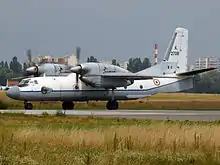
Following the inability to negotiate an end to the Sri Lankan Civil War, and to provide humanitarian aid through an unarmed convoy of ships,[68] the Indian Government decided to carry out an airdrop of the humanitarian supplies on the evening of 4 June 1987 designated Operation Poomalai (Tamil: Garland) or Eagle Mission 4.[68] Five An-32s escorted by four Mirage 2000 of 7 Sqn AF, 'The Battleaxes', carried out the supply drop which faced no opposition from the Sri Lankan Armed Forces. Another Mirage 2000 orbited 150 km away, acting as an airborne relay of messages to the entire fleet since they would be outside radio range once they descended to low levels. The Mirage 2000 escort formation was led by Wg Cdr Ajit Bhavnani, with Sqn Ldrs Bakshi, NA Moitra and JS Panesar as his team members and Sqn Ldr KG Bewoor as the relay pilot.[68][69] Sri Lanka accused India of "blatant violation of sovereignty".[68] India insisted that it was acting only on humanitarian grounds.[68]
In 1987, the IAF supported the Indian Peace Keeping Force (IPKF) in northern and eastern Sri Lanka in Operation Pawan. About 70,000 sorties were flown by the IAF's transport and helicopter force in support of nearly 100,000 troops and paramilitary forces without a single aircraft lost or mission aborted.[70] IAF An-32s maintained a continuous air link between air bases in South India and Northern Sri Lanka transporting men, equipment, rations and evacuating casualties.[70] Mi-8s supported the ground forces and also provided air transportation to the Sri Lankan civil administration during the elections.[70] Mi-25s of No. 125 Helicopter Unit were utilised to provide suppressive fire against militant strong points and to interdict coastal and clandestine riverine traffic.[70]
On the night of 3 November 1988, the Indian Air Force mounted special operations to airlift a parachute battalion group from Agra, non-stop over 2,000 kilometres (1,200 mi) to the remote Indian Ocean archipelago of the Maldives in response to Maldivian president Gayoom's request for military help against a mercenary invasion in Operation Cactus. The IL-76s of No. 44 Squadron landed at Hulhule at 0030 hours and the Indian paratroopers secured the airfield and restored Government rule at Male within hours.[71] Four Mirage 2000 aircraft of 7 Sqn, led by Wg Cdr AV 'Doc' Vaidya, carried out a show of force early that morning, making low-level passes over the islands.
Kargil War (1999)
On 11 May 1999, the Indian Air Force was called in to provide close air support to the Indian Army at the height of the ongoing Kargil conflict with the use of helicopters.[71] The IAF strike was code named Operation Safed Sagar.[71] The first strikes were launched on 26 May, when the Indian Air Force struck infiltrator positions with fighter aircraft and helicopter gunships.[72] The initial strikes saw MiG-27s carrying out offensive sorties, with MiG-21s and later MiG-29s providing fighter cover.[73] The IAF also deployed its radars and the MiG-29 fighters in vast numbers to keep check on Pakistani military movements across the border.[74] Srinagar Airport was at this time closed to civilian air-traffic and dedicated to the Indian Air Force.[72]
On 27 May, the Indian Air Force suffered its first fatality when it lost a MiG-21 and a MiG-27 in quick succession.[notes 1][75][76] The following day, while on an offensive sortie, a Mi-17 was shot down by three Stinger missiles and lost its entire crew of four.[73] Following these losses the IAF immediately withdrew helicopters from offensive roles as a measure against the threat of Man-portable air-defence systems (MANPAD). On 30 May, the Mirage 2000s were introduced in offensive capability, as they were deemed better in performance under the high-altitude conditions of the conflict zone. Mirage 2000s were not only better equipped to counter the MANPAD threat compared to the MiGs, but also gave IAF the ability to carry out aerial raids at night.[77] The MiG-29s were used extensively to provide fighter escort to the Mirage 2000.[78] Radar transmissions of Pakistani F-16s were picked up repeatedly, but these aircraft stayed away. The Mirages successfully targeted enemy camps and logistic bases in Kargil and severely disrupted their supply lines.[79] Mirage 2000s were used for strikes on Muntho Dhalo and the heavily defended Tiger Hill and paved the way for their early recapture.[73] At the height of the conflict, the IAF was conducting over forty sorties daily over the Kargil region.[78] By 26 July, the Indian forces had successfully repulsed the Pakistani forces from Kargil.[80]
Post Kargil incidents (1999–present)
Since the late 1990s, the Indian Air Force has been modernising its fleet to counter challenges in the new century. The fleet size of the IAF has decreased to 33 squadrons during this period because of the retirement of older aircraft. Still, India maintains the fourth largest air force in the world. The IAF plans to raise its strength to 42 squadrons.[81] Self-reliance is the main aim that is being pursued by the defence research and manufacturing agencies.
On 10 August 1999, IAF MiG-21s intercepted a Pakistan Navy Breguet Atlantique which was flying over Sir Creek, a disputed territory. The aircraft was shot down killing all 16 Pakistani Navy personnel on board.[82] India claimed that the Atlantic was on a mission to gather information on IAF air defence,[83] a charge emphatically rejected by Pakistan which argued that the unarmed aircraft was on a training mission.[84]
On 2 August 2002, the Indian Air Force bombed Pakistani posts along the Line of Control in the Kel sector, following inputs about Pakistani military buildup near the sector.[85]
On 20 August 2013, the Indian Air Force created a world record by performing the highest landing of a C-130J at the Daulat Beg Oldi airstrip in Ladakh at the height of 5,065 metres (16,617 ft).[86][87] The medium-lift aircraft will be used to deliver troops, supplies and improve communication networks. The aircraft belonged to the Veiled Vipers squadron based at Hindon Air Force Station.[88]
On 13 July 2014, two MiG-21s were sent from Jodhpur Air Base to investigate a Turkish Airlines aircraft over Jaisalmer when it repeated an identification code, provided by another commercial passenger plane that had already entered Indian airspace before it. The flights were on their way to Mumbai and Delhi, and the planes were later allowed to proceed after their credentials were verified.[89]
2019 Balakot airstrike
Following heightened tensions between India and Pakistan after the 2019 Pulwama attack that was carried out by Jaish-e-Mohammed (JeM) which killed forty-six servicemen of the Central Reserve Police Force,[90][91] a group of twelve Mirage 2000 fighter planes from the Indian Air Force carried out air strikes on alleged JeM bases in Chakothi and Muzaffarabad in the Pakistan-administered Kashmir. Furthermore, the Mirage 2000s targeted an alleged JeM training camp in Balakot, a town in the Pakistani province of Khyber Pakhtunkhwa. Pakistan claimed that the Indian aircraft had only dropped bombs in the forest area demolishing pine trees near the Jaba village which is 19 kilometres (12 mi) away from Balakot[92] and Indian officials claimed to bomb and kill a large number of terrorists in the airstrike.[93]
2019 India–Pakistan standoff
On 27 February 2019, in retaliation for the IAF bombing of an alleged terrorist hideout in Balakot, a group of PAF Mirage-5 and JF-17 fighters allegedly conducted an airstrike against certain ground targets across the Line of Control. They were intercepted by a group of IAF fighters consisting of Su-30MKI and MiG-21 jets. An ensuing dogfight began. According to India, one PAF F-16 was shot down by an IAF MIG-21 piloted by Abhinandan Varthaman, while Pakistan denied use of F-16s in the operation. According to Pakistan, a MiG-21 and a Su30MKI were shot down, while India claims that only the MiG-21 was shot down. While the downed MiG-21's pilot had ejected successfully, he landed in Pakistan-administered Kashmir, and was captured by the Pakistan military. Before his capture he was assaulted by a few locals. After a couple of days of captivity, the captured pilot was released by Pakistan per Third Geneva convention[94] obligations. While Pakistan denied involvement of any of its F-16 aircraft in the strike, the IAF presented remnants of AMRAAM missiles that are only carried by the F-16s within the PAF as proof of their involvement.[95] The US-based ''Foreign Policy'' magazine, quoting unnamed US officials, reported in April 2019 that an audit didn't find any Pakistani F-16s missing.[96] However, the same has not been confirmed by US Official citing it as bilateral matter between US and Pakistan[97]
Structure
The President of India is the Supreme Commander of all Indian armed forces and by virtue of that fact is the national Commander-in-chief of the Air Force. The Chief of the Air Staff with the rank of Air chief marshal is the Commander
| Post | Current Holder |
|---|---|
| Chief of the Air Staff | Air Chief Marshal Rakesh Kumar Singh Bhadauria, PVSM, AVSM, VM, ADC[98] |
| Vice Chief of the Air Staff | Air Marshal Harjit Singh Arora, AVSM, ADC[99] |
| Deputy Chief of the Air Staff | Air Marshal Sandeep Singh, AVSM, VM[100] |
| Air Officer in Charge of Administration | Air Marshal Vijay Pal Singh Rana, VSM[101] |
| Air Officer in Charge of Personnel | Air Marshal Richard John Duckworth, AVSM, VSM[102] |
| Air Officer in Charge of Maintenance | Air Marshal Vibhas Pande, VSM[103] |
| Director General of Inspection and Flight Safety | Air Marshal Gurcharan Singh Bedi, AVSM, VM, VSM[104] |
| Director General of Medical Services (Air) | Air Marshal Pawan Kapoor, VSM Bar, PHS[105][106] |
In January 2002, the government conferred the rank of Marshal of the Indian Air Force on Arjan Singh making him the first and only Five-star officer with the Indian Air Force and ceremonial chief of the air force.[107]
Commands
The Indian Air Force is divided into five operational and two functional commands. Each Command is headed by an Air Officer Commanding-in-Chief with the rank of Air Marshal. The purpose of an operational command is to conduct military operations using aircraft within its area of responsibility, whereas the responsibility of functional commands is to maintain combat readiness. Aside from the Training Command at Bangalore, the primary flight training is done at the Air Force Academy (located in Hyderabad), followed by operational training at various other schools. Advanced officer training for command positions is also conducted at the Defence Services Staff College; specialised advanced flight training schools are located at Bidar, Karnataka and Hakimpet, Telangana (also the location for helicopter training). Technical schools are found at a number of other locations.[108]
| Name | Headquarters | Commander |
|---|---|---|
| Central Air Command (CAC) | Allahabad, Uttar Pradesh | Air Marshal Amit Tiwari, PSVM, AVSM, VM[109] |
| Eastern Air Command (EAC) | Shillong, Meghalaya | Air Marshal Amit Dev, AVSM, VM[110] |
| Southern Air Command (SAC) | Thiruvananthapuram, Kerala | Air Marshal Manavendra Singh, AVSM, VrC, VSM[109] |
| South Western Air Command (SWAC) | Gandhinagar, Gujarat | Air Marshal Surendra Kumar Ghotia, PVSM, VSM[111] |
| Western Air Command (WAC) | New Delhi | Air Marshal Vivek Ram Chaudhari, PSVM, AVSM, VM[112] |
| Training Command (TC)+ | Bangalore, Karnataka | Air Marshal Rajiv Dayal Mathur, PVSM, AVSM, VSM[113] |
| Maintenance Command (MC)+ | Nagpur, Maharashtra | Air Marshal Shashiker Choudhary, VSM[114] |
Note: + = Functional Command
Wings
A wing is a formation intermediate between a command and a squadron. It generally consists of two or three IAF squadrons and helicopter units, along with forward base support units (FBSU). FBSUs do not have or host any squadrons or helicopter units but act as transit airbases for routine operations. In times of war, they can become fully fledged air bases playing host to various squadrons. In all, about 47 wings and 19 FBSUs make up the IAF.[115][116] Wings are typically commanded by an air commodore.[117]
Stations
Within each operational command are anywhere from nine to sixteen bases or stations. Smaller than wings, but similarly organised, stations are static units commanded by a group captain.[117] A station typically has one wing and one or two squadrons assigned to it.
Squadrons and units
Squadrons are the field units and formations attached to static locations. Thus, a flying squadron or unit is a sub-unit of an air force station which carries out the primary task of the IAF. A fighter squadron consists of 18 aircraft; all fighter squadrons are headed by a commanding officer with the rank of wing commander.[118] Some transport squadrons and helicopter units are headed by a commanding officer with the rank of group captain.
Flights
Flights are sub-divisions of squadrons, commanded by a squadron leader. Each flight consists of two sections.[119]
Sections
The smallest unit is the section, led by a flight lieutenant. Each section consists of three aircraft.
Within this formation structure, IAF has several service branches for day-to-day operations. They are:[120]
Flying Branch
|
Technical Branch
|
Ground Branch
|
Garud Commando Force
The Garud commandos are the special forces of the Indian Air Force (IAF). Their tasks include counter-terrorism, hostage rescue, providing security to IAF's vulnerably located assets and various air force-specific special operations. First conceived in 2002, this unit was officially established on February 6, 2004.[121]
.jpg.webp)
All Garuds are volunteers who are imparted a 52-week basic training, which includes a three-month probation followed by special operations training, basic airborne training and other warfare and survival skills. The last phase of basic training sees Garuds been deployed to get combat experience. Advanced training follows, which includes specialised weapons training.[121][122]
The mandated tasks of the Garuds include direct action, special reconnaissance, rescuing downed pilots in hostile territory, establishing airbases in hostile territory and providing air-traffic control to these airbases.[123] The Garuds also undertake suppression of enemy air defences and the destruction of other enemy assets such as radars, evaluation of the outcomes of Indian airstrikes and use laser designators to guide Indian airstrikes.[124]
The security of IAF installations and assets are usually performed by the Air Force Police and the Defence Security Corps even though some critical assets are protected by the Garuds.[121]
Integrated Space Cell
An Integrated Space Cell, which will be jointly operated by all the three services of the Indian armed forces, the civilian Department of Space and the Indian Space Research Organisation (ISRO) has been set up to utilise more effectively the country's space-based assets for military purposes.[17][18] This command will leverage space technology including satellites. Unlike an aerospace command, where the air force controls most of its activities, the Integrated Space Cell envisages co-operation and co-ordination between the three services as well as civilian agencies dealing with space.[125]
India currently has 10[126] remote sensing satellites in orbit. Though most are not meant to be dedicated military satellites, some have a spatial resolution of 1 metre (3 ft 3 in) or below which can be also used for military applications. Noteworthy satellites include the Technology Experiment Satellite (TES) which has a panchromatic camera (PAN) with a resolution of 1 metre (3 ft 3 in),[127] the RISAT-2 which is capable of imaging in all-weather conditions and has a resolution of 1 metre (3 ft 3 in),[128] the CARTOSAT-2, CARTOSAT-2A[129][130] and CARTOSAT-2B[131] which carries a panchromatic camera which has a resolution of 800 millimetres or 31 inches (black and white only).
Display teams
The Surya Kiran Aerobatic Team (SKAT) (Surya Kiran is Sanskrit for Sun Rays) is an aerobatics demonstration team of the Indian Air Force. They were formed in 1996 and are successors to the Thunderbolts.[132] The team has a total of 13 pilots (selected from the fighter stream of the IAF) and operate 9 HAL HJT-16 Kiran Mk.2 trainer aircraft[132] painted in a "day-glo orange" and white colour scheme. The Surya Kiran team were conferred squadron status in 2006, and presently have the designation of 52 Squadron ("The Sharks").[133] The team is based at the Indian Air Force Station at Bidar.[132] The IAF has begun the process of converting Surya Kirans to BAE Hawks.[134]
Sarang (Sanskrit for Peacock) is the Helicopter Display Team of the Indian Air Force. The team was formed in October 2003 and their first public performance was at the Asian Aerospace Show, Singapore, 2004.[135] The team flies four HAL Dhruvs[136] painted in red and white with a peacock figure at each side of the fuselage. The team is based at the Sulur Air Force Station, Coimbatore.
Personnel

Over the years reliable sources provided notably divergent estimates of the personnel strength of the Indian Air Force after analysing open-source intelligence. The public policy organisation GlobalSecurity.org had estimated that the IAF had an estimated strength of 110,000 active personnel in 1994.[108] In 2006, Anthony Cordesman estimated that strength to be 170,000 in the International Institute for Strategic Studies (IISS) publication "The Asian Conventional Military Balance in 2006".[137] In 2010, James Hackett revised that estimate to an approximate strength of 127,000 active personnel in the IISS publication "Military Balance 2010".[138]
As of 1 July 2017, the Indian Air Force has a sanctioned strength of 12,550 officers (12,404 serving with 146 under strength), and 142,529 airmen (127,172 serving with 15,357 under strength).[139][140]
Rank structure
The rank structure of the Indian Air Force is based on that of the Royal Air Force. The highest rank attainable in the IAF is Marshal of the Indian Air Force, conferred by the President of India after exceptional service during wartime. MIAF Arjan Singh is the only officer to have achieved this rank. The head of the Indian Air Force is the Chief of the Air Staff, who holds the rank of Air Chief Marshal.
Officers
Anyone holding Indian citizenship can apply to be an officer in the Air Force as long as they satisfy the eligibility criteria. There are four entry points to become an officer. Male applicants, who are between the ages of 161/2 and 19 and have passed high school graduation, can apply at the Intermediate level.[141] Men and women applicants, who have graduated from college (three-year course) and are between the ages of 18 and 28, can apply at the Graduate level entry.[142] Graduates of engineering colleges can apply at the Engineer level if they are between the ages of 18 and 28 years. The age limit for the flying and ground duty branch is 23 years of age and for technical branch is 28 years of age.[143] After completing a master's degree, men and women between the ages of 18 and 28 years can apply at the Post Graduate level. Post graduate applicants do not qualify for the flying branch. For the technical branch the age limit is 28 years and for the ground duty branch it is 25.[144] At the time of application, all applicants below 25 years of age must be single.[145] The IAF selects candidates for officer training from these applicants. After completion of training, a candidate is commissioned as a Flying Officer.[146]
| Equivalent NATO code | OF-10 | OF-9 | OF-8 | OF-7 | OF-6 | OF-5 | OF-4 | OF-3 | OF-2 | OF-1 | OF(D) and student officer | |||||||||||||||||||||||||
|---|---|---|---|---|---|---|---|---|---|---|---|---|---|---|---|---|---|---|---|---|---|---|---|---|---|---|---|---|---|---|---|---|---|---|---|---|
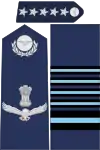 |
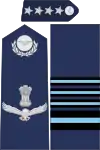 |
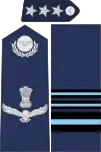 |
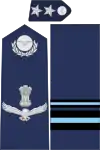 |
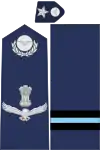 |
 |
 |
 |
 |
 |
|||||||||||||||||||||||||||
| Marshal of the Indian Air Force | Air Chief Marshal | Air Marshal | Air Vice Marshal | Air Commodore | Group Captain | Wing Commander | Squadron Leader | Flight Lieutenant | Flying Officer | Flight Cadet | ||||||||||||||||||||||||||
Airmen
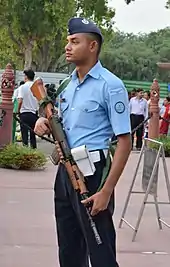
The duty of an airman is to make sure that all the air and ground operations run smoothly. From operating Air Defence systems to fitting missiles, they are involved in all activities of an air base and give support to various technical and non-technical jobs.[147] The airmen of Technical trades are responsible for maintenance, repair and prepare for use the propulsion system of aircraft and other airborne weapon delivery system, Radar, Voice/Data transmission and reception equipment, latest airborne weapon delivery systems, all types of light, mechanical, hydraulic, pneumatic systems of airborne missiles, aero engines, aircraft fuelling equipment and heavy duty mechanical vehicles, cranes and loading equipment etc.[148] The competent and qualified Airmen from Technical trades also participate in flying as Flight Engineers, Flight Signallers and Flight Gunners. The recruitment of personnel below officer rank is conducted through All India Selection Tests and Recruitment Rallies. All India Selection Tests are conducted among 15 Airmen Selection Centres (ASCs) located all over India. These centres are under the direct functional control of Central Airmen Selection Board (CASB), with administrative control and support by respective commands. The role of CASB is to carry out selection and enrolment of airmen from the Airmen Selection Centres for their respective commands.[147] Candidates initially take a written test at the time of application. Those passing the written test undergo a physical fitness test, an interview conducted in English, and medical examination. Candidates for training are selected from individuals passing the battery of tests, on the basis of their performance. Upon completion of training, an individual becomes an Airman.[147] Some MWOs and WOs are granted honorary commission in the last year of their service as an honorary Flying Officer or Flight Lieutenant before retiring from the service.[147]
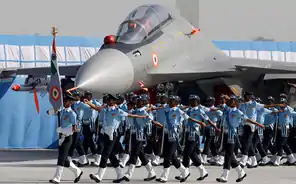
| Equivalent NATO Code | OR-9 | OR-8 | OR-7 | OR-6 | OR-5 | OR-4 | OR-3 | OR-2 | OR-1 | |||||||||||||||||||||||||||
|---|---|---|---|---|---|---|---|---|---|---|---|---|---|---|---|---|---|---|---|---|---|---|---|---|---|---|---|---|---|---|---|---|---|---|---|---|
 |
 |
 |
No equivalent | No insignia | ||||||||||||||||||||||||||||||||
| Master Warrant Officer | Warrant Officer | Junior Warrant Officer | Sergeant | Corporal | Leading Aircraftsman | Aircraftsman | ||||||||||||||||||||||||||||||
Honorary officers
- Sachin Tendulkar was the first sportsperson and the first civilian without an aviation background to be awarded the honorary rank of group captain by the Indian Air Force.[149]
Non combatants enrolled and civilians
Non combatants enrolled (NCs(E)) were established in British India as personal assistants to the officer class, and are equivalent to the orderly or sahayak of the Indian Army.[150]
Almost all the commands have some percentage of civilian strength which are central government employees. These are regular ranks which are prevalent in ministries. They are usually not posted outside their stations and are employed in administrative and non-technical work.[151][152]
Training and education
The Indian Armed Forces have set up numerous military academies across India for training its personnel, such as the National Defence Academy (NDA). Besides the tri-service institutions, the Indian Air Force has a Training Command and several training establishments. While technical and other support staff are trained at various Ground Training Schools, the pilots are trained at the Air Force Academy, Dundigul (located in Hyderabad). The Pilot Training Establishment at Allahabad, the Air Force Administrative College at Coimbatore, the Institute of Aerospace Medicine at Bangalore, the Air Force Technical College, Bangalore at Jalahalli, the Tactics and Air Combat and Defence Establishment at Gwalior, and the Paratrooper's Training School at Agra are some of the other training establishments of the IAF.
List of active Indian Military Aircraft
Current Inventory
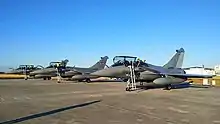

.jpg.webp)
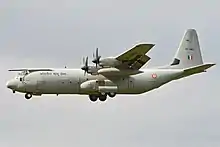
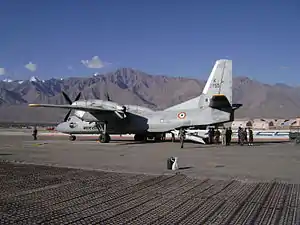
.jpg.webp)
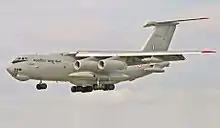
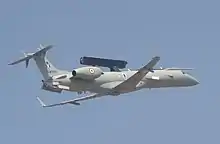
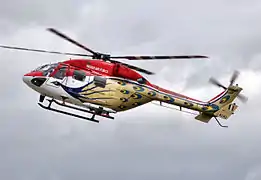
The Indian Air Force has aircraft and equipment of Russian (erstwhile Soviet Union), British, French, Israeli, US and Indian origins with Russian aircraft dominating its inventory. HAL produces some of the Russian and British aircraft in India under licence. The exact number of aircraft in service with the Indian Air Force cannot be determined with precision from open sources. Various reliable sources provide notably divergent estimates for a variety of high-visibility aircraft.[189] Flight International estimates there to be around 1,750 aircraft in service with the IAF,[3] while the International Institute for Strategic Studies provides a similar estimate of 1,750 aircraft.[4] Both sources agree there are approximately 900 combat capable (fighter, attack etc.) aircraft in the IAF.[3][4]
Multi-role fighters and strike aircraft
- Dassault Rafale: The latest addition to India's aircraft arsenal, India has signed a deal for 36 Dassault Rafale multirole fighter aircraft. The first five aircraft including three single-seater and two twin-seater aircraft arrived on 29 July 2020, at the Air Force Station, Ambala. No 17 Squadron, the “Golden Arrows”, is being raised at this base equipped with Rafale aircraft.[190]
- Sukhoi Su-30MKI: The IAF's primary air superiority fighter with the additional capability to conduct air-ground (strike) missions is Sukhoi Su-30MKI. 272 Su-30MKIs are in service as of January 2020 with 12 more on order with HAL.[191]
- Mikoyan MiG-29: The Mikoyan MiG-29 known as Baaz (Hindi for Hawk) is a dedicated air superiority fighter and constitutes the second line of defence after the Sukhoi Su-30MKI. 69 MiG-29s are in service, all of which have been recently upgraded to the MiG-29UPG standard. An additional 21 MiG 29s have been ordered recently with upgraded UPG standard.[192]
- Dassault Mirage 2000: The Dassault Mirage 2000, known as Vajra (Sanskrit for Diamond or thunderbolt) in Indian service, is the primary multirole fighter, the IAF currently operates 49 Mirage 2000Hs and 8 Mirage 2000 TH all of which are currently being upgraded to the Mirage 2000-5 MK2 standard with Indian specific modifications and 2 Mirage 2000-5 MK2 are in service as of March 2015.[193][194] The IAF's Mirage 2000 are scheduled to be phased out by 2030.[195]
- HAL Tejas: The MiG-21s are planned to be replaced by the indigenously built HAL Tejas.[196][197] The first Tejas IAF unit, No. 45 Squadron IAF Flying Daggers was formed on 1 July 2016 followed by No. 18 Squadron IAF "Flying Bullets" on 27 May 2020.[198] Initially being stationed at Bangalore, the first squadron will be placed at its home base at Sulur, Tamil Nadu.[199] The Tejas will be 40 aircraft of the MK1 variant and 83 of the MK1A variant. The latter will have an AESA radar, improved EW fit and internal changes for ease of maintenance.
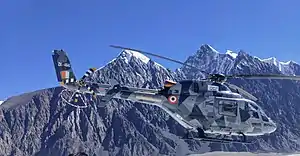
- SEPECAT Jaguar: The SEPECAT Jaguar known as Shamsher serves as the IAF's primary ground attack force.[200] The IAF currently operates 139 Jaguars.[201] The first batch of DARIN-1 Jaguars are now going through a DARIN-3 upgrade being equipped with EL/M-2052 AESA radars, and an improved jamming suite plus new avionics. These aircraft are scheduled to be phased out by 2030.[195]
- Mikoyan-Gurevich MiG-21: The Mikoyan-Gurevich MiG-21 serves as an Interceptor aircraft in the IAF. The IAF have phased out most of its MiG-21s and plans to keep only 125 that have been upgraded to MiG-21 Bison standard.[202] The phase-out date for these aircraft has been postponed several times. Initially set for 2014–2017,[203] it was later postponed to 2019.[204] Currently phase-out is scheduled for 2021–2022.[195]
Airborne early warning and control system
The IAF is currently training the crew in operating the indigenously developed DRDO AEW&CS flying on the Embraer ERJ 145 aircraft. The IAF also operates the EL/W-2090 Phalcon AEW&C incorporated in a Beriev A-50 platform. A total of 3 such systems are currently in service, with possible orders for 2 more.[205][206][207] The two extra Phalcons are currently in negotiation over price differences between Russia and India. India is also going ahead with Project India, an inhouse AWACS program to develop and deliver 6 Phalcon class AWACS, based on DRDO work on the smaller AEW&CS.
Aerial refuelling
The IAF currently operates 7 Ilyushin Il-78MKIs in the aerial refuelling (tanker) role.[208][209]
Transport aircraft
For strategic airlift operations the IAF uses the Ilyushin Il-76, known as Gajraj (Hindi for King Elephant) in Indian service.[210] The IAF operated 17 Il-76s in 2010,[211] which are in the process of being replaced by C-17 Globemaster IIIs.[212][213]
The IAF C-130Js are used by special forces for combined Army-Air Force operations.[214] India purchased six C-130Js; however one crashed at Gwalior on 28 March 2014 while on a training mission, killing all 5 on board and destroying the aircraft.[215][216] The Antonov An-32, known in Indian service as the Sutlej (named after Sutlej River), serves as a medium transport aircraft in the IAF. The aircraft is also used in bombing roles and para-dropping operations.[217] The IAF currently operates 105 An-32s, all of which are being upgraded.[217] The Dornier 228 serves as light transport aircraft in the IAF.[218] The IAF also operates Boeing 737s[219] and Embraer ECJ-135 Legacy aircraft[220] as VIP transports and passenger airliners for troops. Other VIP transport aircraft are used for both the President of India and the Prime Minister of India under the call sign Air India One.[221]
The Hawker Siddeley HS 748 once formed the backbone of the IAF's transport fleet, but are now used mainly for training and communication duties.[222] A replacement is under consideration.[223]
Trainer aircraft
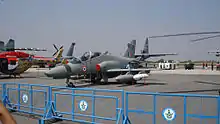
The HAL HPT-32 Deepak is IAF's basic flight training aircraft for cadets.[224] The HPT-32 was grounded in July 2009 following a crash that killed two senior flight instructors,[225] but was revived in May 2010[225] and is to be fitted with a parachute recovery system (PRS) to enhance survivability during an emergency in the air and to bring the trainer down safely.[225] The HPT-32 is to be phased out soon.[225] The HPT 32 has been replaced by Pilatus, a Swiss aircraft. The IAF uses the HAL HJT-16 Kiran mk.I for intermediate flight training of cadets, while the HJT-16 Kiran mk.II provides advanced flight and weapons training.[226][227] The HAL HJT-16 Kiran Mk.2 is also operated by the Surya Kiran Aerobatic Team (SKAT) of the IAF.[228] The Kiran is to be replaced by the HAL HJT-36 Sitara.[229] The BAE Hawk Mk 132 serves as an advanced jet trainer in the IAF and is progressively replacing the Kiran Mk.II. The IAF has begun the process of converting the Surya Kiran display team to Hawks.[134] A total of 106 BAE Hawk trainers have been ordered by the IAF of which 39 have entered service as of July 2010.[230] IAF also ordered 72 Pipistrel Virus SW 80 microlight aircraft for basic training purpose.[231][232]
Helicopters

The HAL Dhruv serves primarily as a light utility helicopter in the IAF. In addition to transport and utility roles, newer Dhruvs are also used as attack helicopters.[233] Four Dhruvs are also operated by the Indian Air Force Sarang Helicopter Display Team.[136] The HAL Chetak is a light utility helicopter and is used primarily for training, rescue and light transport roles in the IAF.[234] The HAL Chetak is being gradually replaced by HAL Dhruv.[234] The HAL Cheetah is a light utility helicopter used for high altitude operations. It is used for both transport and search-and-rescue missions in the IAF.[235]
.jpg.webp)
The Mil Mi-8 and the Mil Mi-17, Mi-17 1V and Mi-17V 5 are operated by the IAF for medium lift strategic and utility roles. The Mi-8 is being progressively replaced by the Mi-17 series of helicopters.[236][237] The IAF has ordered 22 Boeing AH-64E Apache attack helicopters, 68 HAL Light Combat Helicopters (LCH), 35 HAL Rudra attack helicopters, 15 CH-47F Chinook heavy lift helicopters and 150 Mi-17V-5s to replace and augment its existing fleet of Mi-8s, Mi-17s, and Mi-24s.[238] The Mil Mi-26 serves as a heavy lift helicopter in the IAF. It can also be used to transport troops or as a flying ambulance. The IAF currently operates three Mi-26s.[239]
The Mil Mi-35 serves primarily as an attack helicopter in the IAF. The Mil Mi-35 can also act as a low-capacity troop transport. The IAF currently operates two squadrons (No. 104 Firebirds and No. 125 Gladiators) of Mi-25/35s.[240]
Unmanned Aerial Vehicles
The IAF currently uses the IAI Searcher II[241] and IAI Heron[242] for reconnaissance and surveillance purposes. The IAI Harpy serves as an Unmanned Combat Aerial Vehicle (UCAV) which is designed to attack radar systems.[243] The IAF also operates the DRDO Lakshya which serves as realistic towed aerial sub-targets for live fire training.[244]
Land-based missile systems
Surface-To Air Missiles
The air force operates twenty-five squadrons of S-125 Pechora, six squadrons of 9K33 Osa-AK, ten flights of 9K38 Igla-1, eight squadrons of Akash[245] along with a single squadron of SPYDER for air defence.[246][247] Six squadrons of Akash were ordered in 2010 and an order for seven more squadrons is planned.[248] An order for eighteen SPYDER systems was placed in 2008, which is expected to be organised into a total of four squadrons.[249][247]
Ballistic missiles
The IAF currently operates the Prithvi-II short-range ballistic missile (SRBM). The Prithvi-II is an IAF-specific variant of the Prithvi ballistic missile.[250]
Future
The number of aircraft in the IAF has been decreasing from the late 1990s due to the retirement of older aircraft and several crashes. To deal with the depletion of force levels, the IAF has started to modernise its fleet. This includes both the upgrade of existing aircraft, equipment and infrastructure as well as induction of new aircraft and equipment, both indigenous and imported. As new aircraft enter service and numbers recover, the IAF plans to have a fleet of 42 squadrons.[251]
Single-engined fighter
On 3 January 2017, Minister of Defence Manohar Parrikar addressed a media conference and announced plans for a competition to select a Strategic Partner to deliver "... 200 new single engine fighters to be made in India, which will easily cost around (USD)$45 million apiece without weaponry" with an expectation that Lockheed Martin (USA) and Saab (Sweden) will pitch the F-16 Block 70 and Gripen, respectively. An MoD official said that a global tender will be put to market in the first quarter of 2018,[252][253] with a private company nominated as the strategic partners production agency followed by a two or more year process to evaluate technical and financial bids and conduct trials, before the final government-to-government deal in 2021. This represents 11 squadrons of aircraft plus several 'attrition' aircraft.[254] India is also planning to set up an assembly line of American Lockheed Martin F-16 Fighting Falcon Block 70 in Bengaluru. It is not yet confirmed whether IAF will induct these aircraft or not.
In 2018, the defence minister Nirmala Sitharaman gave the go ahead to scale up the manufacturing of Tejas at HAL and also to export Tejas. She is quoted saying "We are not ditching the LCA. We have not gone for anything instead of Tejas. We are very confident that Tejas Mark II will be a big leap forward to fulfil the single engine fighter requirement of the forces.".[255] IAF committed to buy 201 Mark-II variant of the Tejas taking the total order of Tejas to 324.[256] The government also scrapped the plan to import single engine fighters leading to reduction in reliance on imports thereby strengthening the domestic defence industry.[257]
The IAF also submitted a request for information to international suppliers for a stealth unmanned combat air vehicle (UCAV)[258]
Current acquisitions
The IAF has placed orders for 123 HAL Tejas 40 Mark 1 and 83 Mark 1A fighters,[259] 36 Dassault Rafale multi-role fighters,[260] 106 basic trainer aircraft HAL HTT-40, 112 Pilatus PC-7MkII basic trainers,[261][262] 72 HAL HJT-36 Sitara trainers,[134] 72 Pipistrel Virus SW 80 microlight aircraft,[153] 65 HAL Light Combat Helicopters,[263] 139 Mi-17V-5 helicopters,[238][264] 18 Israeli SPYDER Surface to Air Missile (SAM) units,[265] 6 Airbus A330 MRTT [266] 22 AH-64E Apache Longbow heavy attack helicopters,[267] 15 CH-47F medium lift helicopters[268][269] and IAI Harop UCAVs.[243][270]
DRDO and HAL projects
Indian defence companies such as HAL and DRDO are developing several aircraft for the IAF such as the HAL Tejas,[196][197] Advanced Medium Combat Aircraft (AMCA),[271] DRDO AEW&CS (revived from the Airavat Project),[272] NAL Saras,[273] HAL HJT-36 Sitara,[274] HAL HTT-40, HAL Light Combat Helicopter (LCH),[275] HAL Light Utility Helicopter (LUH),[276] DRDO Rustom[277] and AURA (Autonomous Unmanned Research Aircraft) UCAV. DRDO has developed the Akash missile system for the IAF[278][279] and is developing the Maitri SAM with MBDA. DRDO is also developing the Prithvi II ballistic missile.[280]
HAL has undertaken the joint development of the Sukhoi/HAL FGFA (Fifth Generation Fighter Aircraft)[281] (a derivative project of the Sukhoi Su-57) with Russia's United Aircraft Corporation (UAC). HAL is also close to develop its own fifth generation fighter aircraft HAL Amca which will be inducted by 2028. DRDO has entered in a joint venture with Israel Aerospace Industries (IAI) to develop the Barak 8 SAM.[282] DRDO is developing the air-launched version of the BrahMos cruise missile in a joint venture with Russia's NPO Mashinostroeyenia. DRDO has now successfully developed the nuclear capable Nirbhay cruise missile.[283]
Network-centric warfare
The Air Force Network (AFNET), a robust digital information grid that enabled quick and accurate threat responses, was launched in 2010, helping the IAF become a truly network-centric air force. AFNET is a secure communication network linking command and control centres with offensive aircraft, sensor platforms and ground missile batteries. Integrated Air Command and Control System (IACCS), an automated system for Air Defence operations will ride the AFNet backbone integrating ground and airborne sensors, weapon systems and command and control nodes. Subsequent integration with civil radar and other networks shall provide an integrated Air Situation Picture, and reportedly acts as a force multiplier for intelligence analysis, mission control, and support activities like maintenance and logistics. The design features multiple layers of security measures, including encryption and intrusion prevention technologies, to hinder and deter espionage efforts.[284]
Notes
- According to an Indian reports, a MiG-27 crashed from engine trouble and the escorting MiG-21 was shot down by Pakistani fire while trying to aid the downed pilot. The MiG-21 pilot was killed and the MiG-27 pilot was taken as a war prisoner. Pakistan claims both jets were downed by Pakistani air defence after they crossed into its territory. India claims they were lost over Indian territory.
References
- "20% Sailor Shortage in Navy, 15% Officer Posts Vacant in Army, Nirmala Sitharaman Tells Parliament". Archived from the original on 27 December 2017. Retrieved 28 December 2017.
- (Iiss), The International Institute of Strategic Studies (14 February 2017). The Military Balance 2017. Routledge, Chapman & Hall, Incorporated. ISBN 9781857439007.
- "World Air Forces 2016". Flightglobal Insight. 2016. Archived from the original on 5 June 2011. Retrieved 16 January 2016.
- International Institute for Strategic Studies: The Military Balance 2014, p.245
- "The IAF Motto". Retrieved 23 November 2019.
- "Indian Airforce Motto". Shrisanatana. Retrieved 30 November 2019.
- "IAF celebrates 87th Air Force Day - Abhinandan enthrals audience". The Economic Times. Retrieved 6 October 2020.
- "In a first, Rafale fighter jet to feature in Air Force Day parade". Hindustan Times. 3 October 2020. Retrieved 6 October 2020.
- John Pike. "India – Air Force". Archived from the original on 8 February 2010.
- "Indian Air Force". indianairforce.nic.in. Archived from the original on 9 April 2009. Retrieved 4 February 2019.
- "About – The President of India". Archived from the original on 5 April 2016. Retrieved 4 February 2019.
- "20% Sailor Shortage in Navy, 15% Officer Posts Vacant In Army, Nirmala Sitharaman Tells Parliament". News18. Archived from the original on 27 December 2017. Retrieved 28 December 2017.
- "Armed forces facing shortage of nearly 60,000 personnel: Government". The Economic Times. 27 December 2017. Archived from the original on 28 December 2017. Retrieved 28 December 2017.
- "Arjan Singh: IAF's 1965 war hero and the only five-star ranked officer". 16 September 2017. Archived from the original on 19 October 2017.
- "Indian Air For Heraldry (Badges and Insignia)". Bharat Rakshak. Archived from the original on 28 November 2011. Retrieved 16 January 2012.
- Air Force Act, 1950. Ministry of Law & Justice. Archived from the original on 12 January 2012. Retrieved 16 January 2012.
- "India in aerospace defence plan". BBC. 28 January 2011. Archived from the original on 29 September 2009. Retrieved 24 April 2009.
- "India Begins Work On Space Weapons Command". Indo-Asian News Service (IANS). 12 April 2006. Archived from the original on 9 July 2007. Retrieved 23 June 2014.
- "Aid to Civil Power". Archived from the original on 25 July 2010. Retrieved 7 July 2010.
- "HC Deb 3 April 1933 vol 276 cc1473-501". Hansard. Parliament of the United Kingdom. Archived from the original on 3 May 2009. Retrieved 8 April 2009.
- "History of the IAF". Official Website. Webmaster IAF – Air Headquarters. Archived from the original on 9 April 2009. Retrieved 7 April 2009.
- Bedi, Sanjeev (Summer 2008). "Strategic Role of Air Power" (PDF). Air Power Journal. Center for Air Power Studies. 3 (2): 27–45. Archived from the original (PDF) on 23 July 2019. Retrieved 8 April 2009.
- "INDIAN AIR FORCE MUSEUM – Heraldry (Badges and Insignia)". Bharat Rakshak. Archived from the original on 29 March 2010.
- Goyal, S.N. (October 1993). "1939–45 Second World War: Air Force Reminiscences". Sainik Samachar. Indian Air Force. Archived from the original on 6 October 2009. Retrieved 8 April 2009.
- Ahluwalia, A. (2012). Airborne to Chairborne: Memoirs of a War Veteran Aviator-Lawyer of the Indian Air Force. Xlibris Corporation. p. 41. ISBN 978-1-4691-9657-2.
- Engineer, Aspy M. (February 1993). "Air Marshal Aspy Engineer's Recollections". Bharat Rakshak. Archived from the original on 30 December 2009. Retrieved 8 April 2010.
- Lyon 2008, p. 79
- Massey 2005, p. 97
- Barua 2005, p. 192
- Bedi, Sanjeev (Summer 2008). "Strategic Role of Air Power" (PDF). Air Power Journal. Center for Air Power Studies. 3 (2): 27–45. Archived from the original (PDF) on 23 July 2019.
- "The Congolese Rescue Operation". US Army History. Archived from the original on 7 May 2009. Retrieved 25 April 2009.
- Singh, Charanjit. "The Congo Diary" (PDF). Air Power Journal. Center for Air Power Studies. 2 (3): 27–45. Archived from the original (PDF) on 10 July 2007.
- "Air Force History". Global Security. Archived from the original on 5 June 2011. Retrieved 8 July 2010.
- Jagan Pillarisetti. "The Liberation of Goa: 1961". Bharat Rakshak. Archived from the original on 7 January 2012. Retrieved 17 January 2012.
- Pradhan 2010, p. 185
- Jackson, Paul (1988). "Ouragon:Ancestor of Rafale". Air Enthusiast. No.37: 78. ISSN 0143-5450.
- Qadir, Shaukat (9 September 2005). "Operation Gibraltar: Battle that never was". The 1965 War, 40 Years On. Rediff News. Archived from the original on 4 February 2012. Retrieved 17 January 2012.
Pakistan ... undertook a guerrilla operation inside Indian held Kashmir with a large number of regular soldiers ... expecting to be welcomed by the local population and raise them up in arms against the Indian government.
- Pradhan & Chavan 2007, p. xiv
- Thomas 1996, p. 11
- Sisodia & Bhaskar 2005, p. 82
- Gupta 1997, p. 43
- Dixit 2002, p. 149
- "1965 war: We achieved air superiority in three days, says Air Force Marshal Arjan Singh". 4 October 2015. Archived from the original on 14 June 2016. Retrieved 7 August 2016.
- Praval 1975, p. 6
- Jones 1985, p. 78
- Boyne & Fopp 2002, p. 619
- "The Folland Gnat / HAL Ajeet". 1 December 2009. Archived from the original on 12 June 2010. Retrieved 7 July 2010.
- "A Whale of a Fighter: the Su-7 in IAF Service". Bharat Rakshak. Archived from the original on 30 December 2009. Retrieved 5 July 2010.
- Sisson & Rose 1991, p. 229
- Jagan Pillarisetti. "Boyra Encounter – 22nd November 1971". Bharat Rakshak. Archived from the original on 18 November 2011. Retrieved 19 January 2012.
- "Newsweek : the international newsmagazine: US edition". Newsweek: 34. 20 December 1971. ISSN 0028-9604.
Trying to catch the Indian Air Force napping, Yahya Khan, launched a Pakistani version of Israel's 1967 air blitz in hopes that one quick blow would cripple India's far superior air power. But India was alert and Yahya's strategy of scattering his thin air force over a dozen air fields failed!
- Kainikara 2011, p. 195
- "The War of December 1971". Indian Air Force. Archived from the original on 10 April 2009. Retrieved 3 May 2009.
- "Years later, Longewala reminds the do-or-die battle". The Times of India (18 December 2013). India Times. Archived from the original on 18 October 2015. Retrieved 23 August 2015.
- Shorey, Anil (February 2005). "Battle of Longewala: Best of Braves". Sainik Samachar. 52 (4). Archived from the original on 18 March 2009. Retrieved 12 April 2009.
- Mohan, Jagan. "When lightning strikes". Bharat Rakshak. Archived from the original on 28 February 2009. Retrieved 12 April 2009.
- "Bangladesh: Out of War, a Nation Is Born". Time. Time Inc. 20 December 1971. Archived from the original on 23 May 2011. Retrieved 12 April 2011.
- Ramunny, Murkot (1 January 1997). The Sky was the Limit. Northern Book Centre. ISBN 978-81-7211-084-0.
- Simha, Rakesh Krishnan (4 June 2015). "Why the Indian Air Force has a high crash rate". rbth.com. Archived from the original on 1 January 2017. Retrieved 25 July 2016.
- Leonard, Thomas M. (2006). Encyclopedia of the Developing World. Taylor & Francis. p. 806. ISBN 978-0415976640.
- The Encyclopedia of 20th Century Air Warfare, edited by Chris Bishop (Amber publishing 1997, republished 2004 pages 384–387 ISBN 1-904687-26-1)
- Choudhury, Ishfaq Ilahi. "Air aspect of the Liberation War 1971". Daily Star. Archived from the original on 22 March 2009. Retrieved 8 April 2009.
- Ives 2004, p. 186
- Talbott 2006, p. 164
- Wirsing, Robert (15 November 1991). Pakistan's security under Zia, 1977–1988: the policy imperatives of a peripheral Asian state. Palgrave Macmillan, 1991. ISBN 9780312060671.
- Child, Greg (1998). Thin air: encounters in the Himalayas. The Mountaineers Books, 1998. ISBN 9780898865882.
- Desmond/Kashmir, Edward W. (31 July 1989). "The Himalayas War at the Top Of the World". Time.com. Archived from the original on 14 January 2009.
- Pillarisetti, Jagan. "Operation Poomalai – The Jaffna Food drop". The Indian Air Force in Sri Lanka – 1987–90. Bharat Rakshak. Archived from the original on 9 June 2011. Retrieved 17 January 2012.
- Weisman, Steven R. (5 June 1987). "India Airlifts Aid to Tamil Rebels". The New York Times. Retrieved 17 January 2012.
- "OP Pwan". Know Us. Indian Air Force. Archived from the original on 23 November 2010. Retrieved 24 July 2010.
- "Official website of Indian Air Force". Archived from the original on 23 July 2010. Retrieved 28 July 2010.
- "India launches Kashmir air attack". BBC News. 26 May 1999. Archived from the original on 4 May 2009. Retrieved 17 January 2012.
- Camp, Philip. "The Mirage 2000 at Kargil". Kargil 1999. Bharat Rakshak. Archived from the original on 7 August 2011. Retrieved 17 January 2012.
- Bammi 2002
- "India loses two jets". BBC News. 27 May 1999. Archived from the original on 1 January 2008. Retrieved 17 January 2012.
- Dutta, Sujan (22 May 2006). "Flyer pushes frontier again – Nachiketa returns to area where his plane was shot down". Telegraph India. Calcutta, India. Archived from the original on 5 June 2011. Retrieved 17 January 2012.
- "20 years after Kargil War: Man who bombed Tiger Hill tells how the War was won from the air - SP's Aviation".
- Ganguly & Kapur 2008, p. 105
- Jones 2003, p. 97
- Kapur 2007, p. 122
- "IAF to have 42 combat aircraft squadrons". IBNLive. Archived from the original on 6 February 2012.
- "IAF Scores a Kill !!! Factual Account of Interception". Indian Air Force. Archived from the original on 22 July 2009. Retrieved 12 April 2009.
- "IAF shoots down Pak intruder plane". The Indian Express. 11 August 1999. Retrieved 25 April 2009.
- Ian MacKinnon (11 August 1999). "16 dead as India shoots down Pakistani naval plane". The Independent. London. Archived from the original on 18 November 2010. Retrieved 7 June 2009.
- "In a first, IAF acknowledges its jets bombed Pakistani posts across LoC in 2002". Zee News. 24 June 2019. Retrieved 4 July 2019.
- "IAF's C-130J transporter lands near India-China border". Business Standard. 20 August 2013. Archived from the original on 23 August 2013. Retrieved 20 August 2013.
- "10 reasons why IAF's C-130J Super Hercules landing in Daulat Beg Oldie, Ladakh is important". India Today. 20 August 2013. Archived from the original on 20 August 2013. Retrieved 20 August 2013.
- "Indian Air Force lands Super Hercules transport plane on airstrip near LAC". The Indian Express. 20 August 2013. Archived from the original on 20 August 2013. Retrieved 20 August 2013.
- "IAF scrambles fighter jets as Turkish plane sparks alert". Patrika Group. 14 July 2014. Archived from the original on 14 July 2014. Retrieved 14 July 2014.
- "India 'strikes Kashmir militants in Pakistani territory". BBC. BBC. 26 February 2019. Archived from the original on 26 February 2019. Retrieved 25 February 2019.
- "India will 'completely isolate' Pakistan". BBC News. 15 February 2019. Retrieved 16 June 2020.
- "Did Balakot Airstrikes Hit Their Target? Satellite Imagery Raises Doubts". Archived from the original on 2 March 2019. Retrieved 2 March 2019.
- https://www.indiatoday.in/mail-today/story/the-inside-story-of-iaf-s-balakot-strike-1479311-2019-03-16
- "Pakistan to release IAF pilot Abhinandan: What are Geneva Conventions?". businesstoday.in. Archived from the original on 1 March 2019. Retrieved 4 March 2019.
- "IAF shows parts of Amraam missile, says evidence confirms MiG 21 shot down Pakistan's F-16 | India News - Times of India". Archived from the original on 1 March 2019. Retrieved 2 March 2019.
- https://foreignpolicy.com/2019/04/04/did-india-shoot-down-a-pakistani-jet-u-s-count-says-no/
- https://eurasiantimes.com/us-refuses-to-confirm-if-indian-mig-21-shot-down-pakistani-f-16-fighter-jet/
- "Air Chief Marshal RKS Bhadauria takes over as the 26th Chief of the Air Staff" (Press release). Press Information Bureau. 30 September 2019.
- "Air Marshal Harjit Singh Arora AVSM ADC assumes charge as Vice Chief of the Air Staff". 1 October 2019.
- @ANI (30 September 2019). "Air Marshal Sandeep Singh (in pic) appointed as the Deputy Chief of Air Staff of the Indian Air Force. He is succeeding Air Marshal VR Chaudhary who has been posted to the Eastern Air Command" (Tweet) – via Twitter.
- "AIR Marshal Vijay Pal Singh Rana, VSM Takes Over as Air Officer-in-Charge Administration (AOA)". PIB. 3 February 2021.
- "Air Marshal RJ Duckworth takes over as AOP at Air Headquarters Vayu Bhawan". Aviation Defence Universe. Retrieved 7 November 2020.
- @IAF_MCC (1 January 2020). "Air Marshal Vibhas Pande VSM took over as Air Officer-in-Charge Maintenance (AOM) of Indian Air Force with effect from 01 Jan 2020. He succeeded Air Marshal Shashiker Choudhary VSM" (Tweet) – via Twitter.
- "Air Marshal GS Bedi AVSM VMVSM takes over as Director General (Inspection & Safety)". PIB. 3 February 2021.
- "..:: India Strategic ::. APPOINTMENTS: Air Marshal Pawan Kapoor Takes Charge as DGMS (Air)". indiastrategic.in. Archived from the original on 5 June 2011. Retrieved 7 April 2017.
- "Press Information Bureau". Archived from the original on 8 April 2017. Retrieved 7 April 2017.
- "Marshal of the Indian Air Force". Indian Air Force. Archived from the original on 5 June 2011. Retrieved 4 May 2009.
- "Indian Air Force". GlobalSecurity.org. Archived from the original on 8 February 2010. Retrieved 29 June 2010.
- . NDTV. 3 February 2021 https://www.ndtv.com/india-news/air-marshal-manavendra-singh-takes-charge-as-chief-of-indian-air-forces-southern-command-2362146. Missing or empty
|title=(help) - "Air Marshal Amit Dev takes over as Air Officer Commanding-in-Chief of Eastern Air Command". 1 October 2020. Retrieved 8 October 2020.
- "Air Marshal SK Ghotia VSM assumed the command of SWAC". 1 October 2019.
- "Air Marshal VR Chaudhari AVSM VM Assumes Command of Western Air Command". 1 August 2020.
- "Indian Air Force to see major reshuffle at top level on October 1". New Indian Express. 29 September 2020.
- "Choudhary takes over as chief of IAFs Maintenance Command". Outlook. 1 January 2020.
- "Air Force Wings, FBSUs and CMUs". Bharat Rakshak. Archived from the original on 11 June 2009. Retrieved 10 July 2009.
- "Air Force FBSUs and CMUs". Bharat Rakshak. Archived from the original on 11 June 2009. Retrieved 10 July 2009.
- Verma, Bharat; Hiranandani, GM; Pandey, BK (2009). Indian Armed Forces. Lancer Publishers LLC. p. 217. ISBN 9781935501732.
- "Indian Air Force". 10 August 2009. Archived from the original on 5 June 2011. Retrieved 7 July 2010.
- "Indian Air Force : Life in Air Force". webarchive.loc.gov. Archived from the original on 9 April 2009.
- "Indian Air Force: Career Opportunities". Indian Air Force. Archived from the original on 9 April 2009. Retrieved 21 April 2009.
- V.K. Bhatia, Air Marshal (Retd) (October 2009). "Special Forces - Garuds for All Reasons". SP’s Aviation. Retrieved 27 September 2020.
- "Garud: IAF's commando force takes off". Rediff. Press Trust of India. 6 February 2004. Retrieved 17 May 2014.
- "Indian Commandos Heads To Israel For 'Major' Military Drill". Outlook. 10 November 2017. Retrieved 27 September 2020.
- Shukla, Ajai (11 October 2017). "Garud commandoes take first casualties after operating for 12 yrs in J&K". Business Standard India. Retrieved 27 September 2020.
- "India goes to war in space". 18 June 2008. Archived from the original on 11 August 2010. Retrieved 2 July 2010.
- "India attains the capability to target, destroy space satellites in orbit". intoday.in. Archived from the original on 15 May 2012.
- "India's spy satellite boost". BBC. 27 November 2001. Archived from the original on 27 September 2009. Retrieved 31 July 2009.
- Herman, Steve (20 April 2008). "India Launches High-Tech Imaging Satellite". Voice of America. Retrieved 31 July 2009.
- "CARTOSAT-2A". Earth Observation Satellites. ISRO. Archived from the original on 6 January 2012. Retrieved 17 January 2012.
- "NDTV.com: India to launch first military satellite in August". 10 June 2008. Archived from the original on 2 May 2008. Retrieved 18 July 2010.
- "Spy satellite to catch miners, land encroachers". 12 July 2010. Archived from the original on 17 December 2014. Retrieved 23 June 2014.
- "SURYAKIRANS". armedforces.nic.in. Archived from the original on 19 May 2010.
- "Squadrons and Helicopter Units". Bharat Rakshak. Archived from the original on 14 April 2015. Retrieved 17 January 2012.
- "IAF's Surya Kirans to fly Hawk's". 10 October 2010. Archived from the original on 11 October 2010. Retrieved 10 October 2010.
- "ILA 2008: Proud as Peacocks". Archived from the original on 26 May 2009.
- "IAFs Sarang helicopter display team adjudged the best at Berlin air show". 12 June 2008. Archived from the original on 22 March 2012. Retrieved 20 July 2010.
- Cordesman & Kleiber 2006, p. 24
- Hackett 2010, p. 360
- "20% Sailor Shortage in Navy, 15% Officer Posts Vacant In Army, Nirmala Sitharaman Tells Parliament". News18. Archived from the original on 27 December 2017. Retrieved 28 December 2017.
- "Armed forces facing shortage of nearly 60,000 personnel: Government". The Economic Times. 27 December 2017. Archived from the original on 28 December 2017. Retrieved 28 December 2017.
- "Career Opportunities as an Officer: Intermediate (10+2)". Indian Air Force. Archived from the original on 9 April 2009. Retrieved 21 April 2009.
- "Career Opportunities as an Officer: Graduate". Indian Air Force. Archived from the original on 9 April 2009. Retrieved 21 April 2009.
- "Career Opportunities as an Officer: Engineer". Indian Air Force. Archived from the original on 9 April 2009. Retrieved 21 April 2009.
- "Career Opportunities as an Officer: Post Graduate". Indian Air Force. Archived from the original on 9 April 2009. Retrieved 21 April 2009.
- "Career Opportunities as an Officer". Indian Air Force. Archived from the original on 9 April 2009. Retrieved 21 April 2009.
- "Career Graph (for Officers)". Indian Air Force. Archived from the original on 9 April 2009. Retrieved 5 July 2010.
- "Central Airmen Selection Board". Indian Air Force. Archived from the original on 30 April 2009. Retrieved 22 April 2009.
- "CASB". indianairforce.nic.in. Archived from the original on 30 April 2009. Retrieved 4 February 2019.
- "IAF clips Sachin Tendulkar, M S Dhoni wings". indianexpress.com. Archived from the original on 8 April 2013.
- "Air HQ Communication Squadron". Global Security. Archived from the original on 23 January 2011. Retrieved 8 July 2010.
- "Non Combatant(Enrolled) – Pension Chart". Principal Controller of Defence Accounts. Archived from the original on 10 October 2010. Retrieved 6 July 2010.
- "AFRO Career Planning". Indian Air Force. Archived from the original on 23 November 2010. Retrieved 6 July 2010.
- "Les Rafale indiens porteront la dénomination Rafale EH et Rafale DH". defens-aero.com (in French). 11 January 2017.
- "3 more Rafale fighter jets from France arrive in India - Times of India". The Times of India. Retrieved 27 January 2021.
- "Second batch of Rafale aircraft reaches India, says IAF - Times of India". The Times of India. Retrieved 4 November 2020.
- "India's Aviation Behemoth HAL Expects More Orders as It Completes Production of Su-30MKI". Global Security. 3 April 2020.
- "How Sukhoi-30 fighter jets will help check Chinese footprint in Indian Ocean". Hindustan Times. 20 January 2020. Retrieved 21 January 2020.
- Pubby, Manu. "IAF to urgently procure 21 MiG 29s, 12 Su 30s". The Economic Times. Retrieved 17 September 2020.
- Jennings, Gareth (12 December 2012). "Indian Air Force receives back first upgraded MiG-29 fighters". IHS Jane's Defence Weekly. 50 (2). ISSN 2048-3430.
- "World Air Forces 2021". Flightglobal Insight. 2020. Retrieved 23 December 2020.
- "IAF MiG-29 fighter aircraft crashes near Jalandhar". The Hindu. 8 May 2020. Retrieved 8 May 2020.
- "HAL to ramp up Tejas fighter tests after pandemic pause". The Week.
- http://idrw.org/5-foc-tejas-mk1-by-march-end-hal-chief/
- "Defence Ministry, Indian Air Force bring down 83 LCA deal cost by over Rs 10,000 crore". 19 December 2019. Retrieved 24 December 2019.
So far, around 18 LCAs have been delivered to the IAF
- Aroor, Shiv. "Finally, Decks Cleared For $5.2 Billion LCA Tejas Fighter Order". livefistdefence.com. Retrieved 27 May 2020.
- https://theprint.in/defence/contract-signed-for-83-lca-tejas-fighters-all-eyes-now-on-hal-delivery-schedule/597841/
- Jennings, Gareth (6 August 2014). "Indian Air Force Jaguar lost on training sortie". IHS Jane's Defence Weekly. 51 (37). ISSN 2048-3430.
- "Chapter Six: Asia". The Military Balance. 119 (1): 266–272. 15 February 2019. doi:10.1080/04597222.2018.1561032. ISSN 1479-9022. S2CID 219624604.
- "Statement by Official Spokesperson on 27 February 2019". Press Information Bureau, Government of India. 27 February 2019. Retrieved 28 February 2019.
- Bedi, Rahul (30 November 2017). "IAF refuels its EMB-145 AEW&C aircraft in mid-air". Jane's Defence Weekly. Archived from the original on 30 November 2017.
- Menon, Jay (23 April 2013). "RFP Coming Soon For Indian Airborne Jamming Aircraft". aviationweek.com. AWIN First.
- Mukherjee, Amit (29 September 2004). "IAF to get 5th IL-78 refueller soon - Times of India". The Times of India.
- "PM's new special aircraft, equipped with missile defence systems, lands in Delhi". Hindustan Times. 1 October 2020. Retrieved 1 October 2020.
- "India's Air Force One takes off on first official flight". dna. PTI. 1 April 2009.
- "More than half of IAF's AN-32 upgraded: MoS Defence informs Rajya Sabha". 15 July 2019.
At present, Indian Air Force (IAF) has 98 AN-32 aircraft and none of the aircraft has outlived its operational life
- "41 AN-32 aircraft require upgrade, process under way: Defence Ministry". 8 July 2019.
There are 53 upgraded AN-32 aircraft in the fleet
- "India gets first Embraer jet with Indian airborne radar tech". The Hindu Business Line. PTI. 17 August 2012.
- Jackson, Paul; Munson, Kenneth; Peacock, Lindsay, eds. (2004). "HAL (Dornier) 228". Jane's All the World's Aircraft (95th year of issue 2004-2005. ed.). Coulsdon: Janes Information Group. p. 206. ISBN 0710626142.
- "Purchase of Transport Aircraft". Press Information Bureau. 12 December 2011.
- "Two HAL light combat choppers deployed in Ladakh". Hindustan Times. 12 August 2020. Retrieved 14 August 2020.
The two LCHs deployed in Ladakh are prototypes
- Aroor, Shiv. "Make Time For This Sweet Shoot Of India's RUDRA Armed Helo".
- Dutta, Amrita Nayak (4 October 2019). "IAF's heavy-lift Mi-26 choppers set to fly back to Russia for overhaul". ThePrint. Retrieved 27 December 2020.
- Bedi, Rahul (20 February 2013). "India signs up for more Heron UAVs". IHS Jane's Defence Weekly. 50 (12). ISSN 2048-3430.
- Mallapur, Chaitanya (4 May 2015). "India tops list of drone-importing nations". IndiaSpend. Business Standard.
- Bedi, Rahul (16 September 2015). "India to buy Heron TP UAVs". IHS Jane's Defence Weekly. 52 (44). ISSN 2048-3430.
- "Hindustan Aeronautics Limited delivers 'Lakshya-1' aircraft to Bharat Dynamics Limited". Indian Express. 27 July 2013. Retrieved 3 August 2013.
- "Restored Dakota DC3 aircraft to join IAF vintage fleet - Restored to past glory". The Economic Times. Retrieved 18 October 2020.
- "Air Force Equipment". Global Security.org. Archived from the original on 5 May 2009. Retrieved 22 April 2009.
- "FERRY OF RAFALE". Indian air force (Press release). 29 July 2020.
- "Mig-29UPG modernization near completion at 11 BRD". Business-standard.com. 22 September 2016. Archived from the original on 5 June 2011.
- "Two IAF Mirage aircraft flown to France for upgradation". 6 December 2011. Archived from the original on 2 February 2012. Retrieved 27 December 2011.
- "French jet Rafale bags $20bn IAF fighter order; India 'briefs' losing European countries". The Times of India. 1 February 2012. Archived from the original on 4 May 2013.
- "MiG-21 a relic that continues to fly". 20 July 2018. Archived from the original on 22 February 2019. Retrieved 28 February 2019.
- "LCA Tejas makes successful flight". The Times of India. 23 April 2010. Archived from the original on 3 June 2010.
- "Light combat aircraft flies with near-full gear". Daily News and Analysis. India. Archived from the original on 11 May 2011.
- https://www.youtube.com/watch?v=w6xyh0CtO74
- "Tejas: IAF inducts HAL's 'Made in India' Light Combat Aircraft – 10 special facts about the LCA". The Financial Express. 1 July 2016. Archived from the original on 16 August 2016. Retrieved 1 July 2016.
- Naik, V.P. (26 September 2008). "IAF aiming for Diverse Capabilities, says Vice Chief of Air Staff". Air Marshal P V Naik's Keynote Address on Fighter Technology and Advance Systems. India Strategic. Archived from the original on 31 January 2009. Retrieved 22 April 2009.
- "HAL To Tie-Up With BAE Systems For Jaguar Upgrade". 30 November 2009. Archived from the original on 1 November 2010. Retrieved 23 July 2010.
- "Indi's Fighter Modernisation: Add MiG-29s to the List". Defense Industry Daily. 28 April 2011. Archived from the original on 13 February 2011. Retrieved 17 January 2011.
- "MiG 21s to be phased out from 2014: Antony". The Hindu. PTI. 29 February 2012. ISSN 0971-751X. Archived from the original on 28 December 2013. Retrieved 28 February 2019.CS1 maint: others (link)
- Vinay Kumar (16 June 2013). "MiG-21bis likely to serve IAF until 2019". The Hindu. Archived from the original on 19 April 2014. Retrieved 29 November 2015.
- "Russia sends 3rd AWACS plane to India". 4 November 2010. Archived from the original on 6 November 2010. Retrieved 4 November 2010.
- "First AWACS aircraft lands at Jamnagar air base in Gujarat". The Hindu. Chennai, India. 26 May 2009. Archived from the original on 4 November 2012.
- "India set to decide big military aircraft deals". India Strategic. Archived from the original on 3 January 2014.
- Mukherjee, Amit (29 September 2004). "IAF to get 5th IL-78 refueller soon". The Times of India. Archived from the original on 17 February 2009. Retrieved 22 April 2009.
- Kopp, Carlo (7 July 2007). "The PLA-AF's Aerial Refuelling Programmes". Air Power Australia: 1. Archived from the original on 23 June 2009. Retrieved 22 April 2009. Cite journal requires
|journal=(help) - "Illyushin Il-76MD [Candid] Gajraj". Archived from the original on 26 May 2010. Retrieved 10 July 2010.
- "C-17 Globemaster: IAF's new heavy lift transport aircraft". 28 April 2010. Archived from the original on 8 July 2011. Retrieved 2 September 2010.
- Bedi, Rahul (5 July 2010). "IAF completes C-17 test-flight". Archived from the original on 5 June 2011. Retrieved 21 July 2010.
- "Indian Air Force :: Illyushin 76MD, 78MKI, A-50 – Serials". Bharat-rakshak.com. Archived from the original on 21 February 2012. Retrieved 24 September 2011.
- "Lockheed delivers fifth C130J to IAF". Archived from the original on 1 August 2013. Retrieved 9 December 2011.
- "IAF Super Hercules Crash: 5 Air Force Personnel killed in Gwalior". IANS. news.biharprabha.com. 28 March 2014. Archived from the original on 31 March 2014. Retrieved 28 March 2014.
- "Deals for Acquisition of C-130 J Super Hercules (Press Release)". 7 December 2011. Archived from the original on 2 May 2013. Retrieved 16 December 2011.
- "IAF An-32 planes in Ukraine for upgrades". 21 March 2010. Archived from the original on 8 May 2010. Retrieved 20 July 2010.
- "Dornier 228". Bharat Rakshak. Archived from the original on 20 April 2010. Retrieved 10 July 2010.
- "Boeing 737". Bharat Rakshak. Archived from the original on 20 April 2010. Retrieved 10 July 2010.
- "Embraer EMB135 Legacy". Bharat Rakshak. Archived from the original on 14 April 2010. Retrieved 10 July 2010.
- "April 1 date for President with business jets". Zee News. 16 March 2009. Archived from the original on 7 May 2012. Retrieved 8 April 2011.
- "HAL HS 748M Avro". Bharat Rakshak. Archived from the original on 20 April 2010. Retrieved 10 July 2010.
- "India clears $2.4 billion plan to buy cargo planes for Air Force". IANS. Archived from the original on 18 January 2013. Retrieved 17 August 2012.
- "HAL HPT-32 Deepak". Bharat Rakshak. Archived from the original on 6 December 2008. Retrieved 23 April 2009.
- Sharma, Ravi (16 May 2010). "IAF gives nod for HPT-32 revival". The Hindu. Chennai, India. Archived from the original on 11 October 2013. Retrieved 17 May 2010.
- "HAL HJT-16 Kiran Mk.1/1A". Bharat Rakshak. Archived from the original on 22 March 2009. Retrieved 23 April 2009.
- "HAL HJT-16 Kiran Mk.II". Bharat Rakshak. Archived from the original on 4 October 2008. Retrieved 23 April 2009.
- "SURYAKIRANS". Archived from the original on 19 May 2010. Retrieved 20 July 2010.
- "HJT-36 Sitara Intermediate Jet Trainer, India". Archived from the original on 13 April 2010. Retrieved 6 July 2010.
- "India inks deal with BAE for 57 Hawk aircraft". The Times of India. 28 July 2010. Archived from the original on 1 August 2010. Retrieved 31 July 2010.
- "India Inks World's Largest Microlight Aircraft Deal With Slovenian Firm". New Delhi: Arming India. 12 October 2015. Archived from the original on 7 April 2016. Retrieved 7 August 2016.
- The Financial Express (12 October 2015). "India inks Rs 130-crore deal for 194 microlight aircraft". financialexpress.com. Archived from the original on 17 August 2016. Retrieved 7 August 2016.
- "HAL Dhruv". Archived from the original on 30 March 2010. Retrieved 20 July 2010.
IAF Dhruvs, can carry a 20mm gun plus eight anti-tank guided missiles (ATGMs) or four air-to-air missiles or four 68mm rocket pods on outriggers.
- "HAL Chetak (Alouette III)". Archived from the original on 7 February 2010. Retrieved 20 July 2010.
- "HAL Cheetah (Alouette II)". Archived from the original on 29 March 2010. Retrieved 20 July 2010.
- "Mil Mi-8 (Hip) Rana". Archived from the original on 30 March 2010. Retrieved 7 July 2010.
- "Mil Mi-17 (Hip) Pratap". Archived from the original on 21 April 2010. Retrieved 7 July 2010.
- Gulshan Luthra and Air Marshal Ashok Goel (Retd) (August 2010). "Russia continues to dominate Indian military aviation". India Strategic. Archived from the original on 22 August 2010. Retrieved 20 August 2010.
- "Mil Mi-26 (Halo)". Archived from the original on 29 March 2010. Retrieved 20 July 2010.
- "Mil Mi-25 / Mi-35 (Hind) Akbar". Archived from the original on 29 March 2010. Retrieved 20 July 2010.
- "Searcher Mk II Delivered To India". israeli-weapons.com. Archived from the original on 9 April 2009. Retrieved 22 April 2009.
- "Heron MALE System—Medium Altitude Long Endurance UAV". defence-update.com. Archived from the original on 7 February 2009. Retrieved 22 April 2009.
- Pandit, Rajat (5 July 2010). "Air Force hunts for combat drones". The Times of India. Archived from the original on 5 June 2011. Retrieved 14 July 2010.
- "Press Information Bureau". Government of India. Archived from the original on 9 December 2007. Retrieved 22 April 2009.
- Pandit, Rajat (13 September 2019). "Akash missile: Rs 5400 crore deal inked for 7 more squadrons of Akash missiles for IAF". The Times of India.
- "Chapter Six: Asia". The Military Balance. 118 (1): 264. 13 February 2018. doi:10.1080/04597222.2018.1416982. S2CID 219623091.
- Bhatia, VK Jimmy (July 2018). "Six Vendors Respond to IAF RFI for 110 Combat Jets, says Air Chief Marshal Dhanoa – India Strategic". India Strategic. Archived from the original on 23 January 2019. Retrieved 22 January 2019.
- Kumar, Chetan (17 February 2015). "Six new Akash squadrons to give IAF missile muscle". The Times of India. Archived from the original on 10 January 2017. Retrieved 22 January 2019.
- "Indian Air Force: IAF orders Israeli Spyder Missile". India Strategic. September 2008. Archived from the original on 28 April 2017. Retrieved 22 January 2019.
- "Prithvi". 5 November 2002. Archived from the original on 11 November 2010. Retrieved 17 July 2010.
- "IAF fighter squadrons to rise to 42 by 2022: Antony". The Times of India. 18 February 2009. Archived from the original on 21 February 2009. Retrieved 24 April 2009.
- "RFI for Fighter Aircraft For The Indian Air Force".
- "Request for information for procurement of fighteraircraft fir the Indian air force" (PDF).
- Parrikar: India to Kick Off Competition for New Foreign Single-Engine Fighters Archived 5 June 2011 at the Wayback Machine, Vivek Raghuvanshi, DefenseNews.com, 3 January 2017
- "Not ditched Tejas jet, looking to speed up production: Nirmala – Times of India". The Times of India. Archived from the original on 12 June 2018. Retrieved 23 March 2018.
- "IAF commits to 324 Tejas fighters, provided a good Mark-II jet is delivered – Times of India". The Times of India. Archived from the original on 23 March 2018. Retrieved 23 March 2018.
- "Govt shelves $10-b single-engine fighter jet deal, to push for Tejas". @businessline. Retrieved 23 March 2018.
- "India canvasses global suppliers for stealthy UCAV". 7 July 2010. Archived from the original on 10 July 2010. Retrieved 12 July 2010.
- "Air force to get 20 more Tejas fighter aircraft, says Antony". 7 July 2010. Archived from the original on 16 July 2010.
- "India Signs Rs 58,000-Crore Deal For 36 Rafale Fighter Jets With France". ndtv.com. Archived from the original on 23 September 2016. Retrieved 23 September 2016.
- Jay Menon (16 June 2011). "India Selects Pilatus Basic Trainer". Aviation Week. Retrieved 19 June 2011.
- Shukla, Ajai (4 February 2013). "IAF to order 37 more Pilatus trainers worth Rs 1,250 cr". Business Standard India. Business Standard. Archived from the original on 5 June 2011. Retrieved 7 May 2013.
- "Light Combat Helicopter (LCH)". Knol. 17 August 2010. Archived from the original on 5 April 2010. Retrieved 23 August 2010.
- "IAF orders additional 59 Mi-17 choppers from Russia". domain-b.com. 9 September 2010. Archived from the original on 15 September 2010. Retrieved 9 September 2010.
- "IAF orders Israeli Spyder Missile". September 2008. Archived from the original on 5 June 2011. Retrieved 12 July 2010.
- "Airbus Wins India's Tanker Rebid". 31 October 2012. Archived from the original on 5 June 2011. Retrieved 1 November 2012.
- "Airbus Wins India's Tanker Rebid". 1 November 2012. Archived from the original on 5 June 2011. Retrieved 1 November 2012.
- "India's defence ministry has cleared deals for 22 AH-64E Apache and 15 CH-47F Chinook helicopters". 26 May 2015. Archived from the original on 23 June 2015.
- "US pips Russia as 'lowest bidder' for heavy-lift 15-chopper deal". The Times of India. 28 October 2012. Archived from the original on 28 October 2012. Retrieved 28 October 2012.
- Egozi, Arie (9 April 2010). "Indian air force orders Harop loitering munitions". Archived from the original on 4 May 2010. Retrieved 14 July 2010.
- "India reveals plan to develop indigenous medium fighter". Archived from the original on 10 February 2009.
- "Cabinet panel nod for 'Airawat' project". The Hindu. 10 September 2004. Archived from the original on 10 January 2009. Retrieved 24 April 2009.
- "Lighter version of Saras aircraft to fly out next year". The Hindu. Chennai, India. 26 June 2008. Archived from the original on 2 October 2008.
- "HAL's intermediate jet trainer HJT-36 makes maiden flight with Russian engine". The Hindu. Chennai, India. 14 May 2009. Archived from the original on 16 June 2009. Retrieved 12 July 2010.
- "Light Combat Helicopter (LCH)Specifications". GlobalSecurity.org. Archived from the original on 17 February 2015. Retrieved 26 April 2009.
- "HAL looks at foreign partners for chopper project". The Times of India. 29 September 2008. Archived from the original on 3 January 2009.
- "India developing UAV similar to American Predator drone". The Economic Times. 14 November 2011. Archived from the original on 27 December 2011. Retrieved 16 January 2012.
- "IAF initiates process for inducting Akash and Trishul SAM's". Frontier India. 3 May 2007. Archived from the original on 16 June 2012. Retrieved 23 April 2009.
- "IAF to induct Akash missile". The Indian Express. 26 December 2007. Archived from the original on 5 June 2011. Retrieved 24 April 2009.
- "Prithvi". Federation of American Scientists. Archived from the original on 22 December 2008. Retrieved 24 April 2009.
- Pubby, Manu (12 October 2007). "India, Russia to ink pact for developing fighters". The Indian Express. Retrieved 1 August 2009.
- "Barak-2 LR-SAM maiden flight later this year". 1 February 2010. Archived from the original on 12 April 2010. Retrieved 12 July 2010.
- "IAF Sukhoi Fleet to be Equipped with Homemade Nirbhay Missiles". 21 May 2010. Archived from the original on 25 May 2010. Retrieved 16 July 2010.
- "IAF's AFNET NCW Backbone Goes Live Next Week". Archived from the original on 4 October 2013. Retrieved 1 October 2013.
Bibliography
- Bammi, Y.M. (2002). Kargil 1999, Impregnable Conquered. Gorkha Publishers. pp. xxviii, 558, 65, 8 p. ISBN 978-81-7525-352-0. LCCN 2003305922.
- Bajwa, Kuldip Singh (2005). The Dynamics of Soldiering. Har-Anand Publications. p. 292. ISBN 978-81-241-0940-3.
- Barua, Pradeep (2005). The State at War in South Asia. University of Nebraska Press. pp. xvi, 437. ISBN 978-0-8032-1344-9.
- Boyne, Walter J.; Fopp, Michael (2002). Air Warfare: An International Encyclopedia (Illustrated ed.). ABC-CLIO. pp. xvi, 437. ISBN 978-1-57607-345-2.
- Chadha, Vivek (2005). Low Intensity Conflicts in India (Illustrated ed.). SAGE. p. 513. ISBN 978-0-7619-3325-0.
- Coggins, Ed (2000). Wings That Stay on (Illustrated ed.). Turner Publishing Company. pp. iii, 244. ISBN 978-1-56311-568-4.
- Cordesman, Anthony H.; Kleiber, Martin (2006). The Asian Conventional Military Balance in 2006: Overview of major Asian Powers (PDF). Center for Strategic & International Studies. p. 48.
- Dixit, Jyotindra Nath (2002). India-Pakistan in War & Peace. Routledge. p. 501. ISBN 978-0-415-30472-6.
- Europa Publications (2005). Far East and Australasia 2003. Europa Publications. p. 1538. ISBN 978-1-85743-133-9.
- Ganguly, Sumit; Kapur, S. Paul (2008). Nuclear Proliferation in South Asia (illustrated ed.). Taylor & Francis. pp. xii, 251. ISBN 978-0-415-44049-3.
- Gupta, Amit (1997). Building an Arsenal: The Evolution of Regional Power Force Structures (Illustrated ed.). Greenwood Publishing Group. pp. xi, 217. ISBN 978-0-275-95787-2.
- Ives, Jack D. (2004). Himalayan Perceptions: Environmental Change and the Well-being of Mountain Peoples (Illustrated ed.). Routledge. pp. xxi, 271. ISBN 978-0-415-31798-6.
- International Institute for Strategic Studies (2002). The Military Balance 2002/2003 (Map ed.). International Institute for Strategic Studies. ISBN 978-0-19-851672-9.
- International Institute for Strategic Studies; Hackett, James (ed.) (3 February 2010). The Military Balance 2010. London: Routledge. ISBN 978-1-85743-557-3.CS1 maint: extra text: authors list (link)
- Jones, Aubrey (1985). Britain's Economy: The Roots of Stagnation (illustrated ed.). Cambridge University Press. ISBN 978-0-521-30816-8.
- Jones, Owen Bennett (2003). Pakistan: Eye of the Storm (2, illustrated, revised ed.). Yale University Press. p. 328. ISBN 978-0-300-10147-8.
- Kainikara, Sanu (2007). Red Air: Politics in Russian Air Power. Universal Publishers. ISBN 978-1-58112-983-0.
- Kapur, S. Paul (2007). Dangerous Deterrent: Nuclear Weapons Proliferation and Conflict in South Asia (Annotated ed.). Stanford University Press. p. 280. ISBN 978-0-8047-5549-8.
- Karthikeyan, K.R.; Gupta; Sendilkumar, R.; Jaganathan, D. (2008). A Textbook of Agricultural Extension Management. Atlantic Publishers & Distributors. pp. v, 192. ISBN 978-81-269-0881-3.
- Khan, J.A. (2004). Air Power and Challenges to IAF. APH Publishing. pp. xxxii, 361. ISBN 978-81-7648-593-7.
- Lyon, Peter (2008). Conflict Between India and Pakistan: An Encyclopedia (illustrated ed.). ABC-CLIO. ISBN 978-1-57607-712-2.
- Massey, Reginald (2005). Azaadi!. Abhinav Publications. ISBN 978-81-7017-469-1.
- Pradhan, R.D. (1999). Debacle to Revival: Y.B. Chavan as Defence Minister, 1962–65. Orient Blackswan. pp. xii, 316. ISBN 978-81-250-1477-5.
- Pradhan, R. D.; Chavan, Yashwantrao Balwantrao (2007). 1965 War, the Inside Story: Defence Minister Y.B. Chavan's Diary of India-Pakistan War. Atlantic Publishers & Distributors. pp. xviii, 141. ISBN 978-81-269-0762-5.
- Praval, Karam Chand (1975). India's Paratroopers (A History of the Parachute Regiment of India). Leo Cooper, London. ISBN 978-0-85052-184-9.
- Shiva, Vandana (2005). India Divided: Diversity and Democracy Under Attack. Seven Stories Press. p. 191. ISBN 978-1-58322-540-0.
- Sisodia, N.S.; Bhaskar, Chitrapu Uday (2005). Emerging India: Security and Foreign Policy Perspectives. Bibliophile South Asia. pp. xx, 376. ISBN 978-81-86019-51-1.
- Sisson, Richard; Rose, Leo E. (1991). War and Secession: Pakistan, India, and the Creation of Bangladesh (revised ed.). University of California Press. ISBN 978-0-520-07665-5.
- Thomas, Raju G.C. (1996). India's Security Environment: Towards the Year 2000. DIANE Publishing. pp. iv, 33. ISBN 978-1-4289-1389-9.
- Tiwary, AK, Air Vice Marshal (2012). Indian Air Force in wars. New Delhi: Lancer. ISBN 9781935501336.
- Warikoo, K. (2009). Himalayan Frontiers of India: Historical, Geo-Political and Strategic Perspectives (Illustrated ed.). Taylor & Francis. pp. xv, 240. ISBN 978-0-415-46839-8.
- Wilson, Stewart (2002). North American F-86 SABRE (Illustrated ed.). Wilson Media Pty, Limited. p. 64. ISBN 978-1-876722-05-0.
External links
| Wikimedia Commons has media related to Indian Air Force. |
- Official website of The Indian Air Force
- 1965, IAF Claimed its First Air-to-Air Kill documentary published by IAF
- Indian Air Force on bharat-rakshak.com
- Global Security article on Indo-Pakistani Wars
- Designators Batches of Indian Air Force
- Career Air Force Government of India
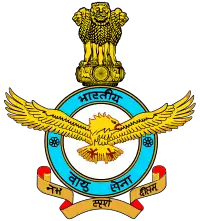



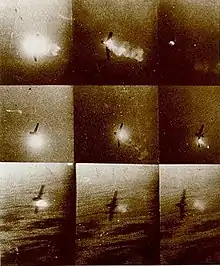
.jpg.webp)
